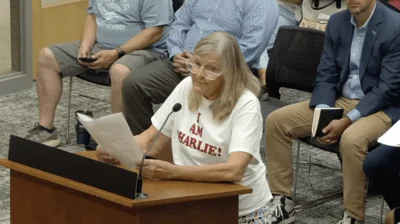Wheaton-Warrenville School District 200's board has approved a referendum that would increase the district's debt to $280 million, or fourth-highest per capita of 42 districts in DuPage County | Wheaton-Warrenville CUSD 200
Wheaton-Warrenville School District 200's board has approved a referendum that would increase the district's debt to $280 million, or fourth-highest per capita of 42 districts in DuPage County | Wheaton-Warrenville CUSD 200
Over the past two decades, Wheaton-Warrenville Unit School District 200 local property tax spending has risen 30 percent, while district enrollment has fallen eight percent.
That’s according to an analysis of school spending reports by Local Government Information Services (LGIS), which publishes DuPage Policy Journal.
The analysis uses data provided by the Illinois State Board of Education (ISBE) and inflation-adjusts all spending figures.
Wheaton-Warrenville District 200 had 13,076 students and spent $126.2 million in local property taxes in 1997.
In 2015, enrollment was 8.1 percent lower (11,975 students) and the district spent 30.0 percent more local dollars, or $150.3 million.
Total district spending, which includes state and federal grants to District 200, has increased at a similar rate-- 29.9 percent. District 200 spent $175.6 million in 2015, up from $135.2 million in 1997.
The analysis comes as teachers and school district officials push an Apr. 4 referendum to increase Wheaton and Warrenville local property tax spending by $206 million or approximately 150 percent of its total annual tax levy.
Enrollment falls, school debt ceiling looms
The referendum proposes borrowing $132.5 million and paying another $73.5 million in interest. Supporters want to spend $16.6 million building a new elementary school and more than $100 million renovating existing schools.
A 2015 Chicago Tribune study of school district borrowing showed Wheaton-Warrenville District 200 already had $174.6 million in debt, or 48 percent of its state-mandated debt limit.
If the referendum is approved, District 200 will have $280 million in debt, or 77 percent of its capacity.
Only three of DuPage County’s 42 districts would hold more debt per capita than Wheaton-Warrenville District 200-- Queen Bee District 16 in Glendale Heights (98 percent), Bensenville District 2 (95 percent) and West Chicago Elementary District 33 (82 percent).
District 200 enrollment has fallen steadily over the past 20 years, though at an increased clip more recently. Fewer students have enrolled in four of the past five and nine of the past ten years.
Property taxes rise, Wheaton, Warrenville home values falling
A recent LGIS analysis of DuPage County home values and property taxes found that the median sale price in Wheaton fell 22 percent from 2007 to 2015, from $401,228 to $313,000.
In Warrenville, prices fell 35 percent, from $272,058 to $178,000.
Rising property taxes have been a contributing factor.
A 2015 Chicago Tribune report pegged the effective property tax rates in Wheaton and Warrenville at 2.66 percent and 2.67 percent, respectively.
At that rate, the average property tax bill on a $300,000 home would be $8,010, or more than three times what it is in Indiana ($2,610), where the rate is 0.87 percent.
If home values fall at the same rate, median home prices in Wheaton will fall to $279,114 in 2023, according to LGIS. The average Wheaton homeowner will have paid $133,714 in property taxes over the previous 16 years.
In Warrenville, LGIS projects the median home value would fall to $133,126, with the average taxpayer having paid $74,902 in taxes over the period.
Wheaton-Warrenville CUSD 200 Local Property Tax Spending vs. Enrollment, 1997 to 2015
| Year | Local Spending | % CHG | Enrollment | % CHG |
| 1997 | $115,569,852 | - | 13,025 | - |
| 1998 | $114,898,846 | -0.6% | 12,789 | -1.8% |
| 1999 | $120,881,646 | 5.2% | 12,670 | -0.9% |
| 2000 | $122,219,719 | 1.1% | 13,605 | 7.4% |
| 2001 | $124,593,528 | 1.9% | 13,052 | -4.1% |
| 2002 | $124,262,394 | -0.3% | 13,235 | 1.4% |
| 2003 | $126,218,272 | 1.6% | 13,076 | -1.2% |
| 2004 | $128,814,233 | 2.1% | 13,030 | -0.4% |
| 2005 | $132,228,703 | 2.7% | 12,281 | -1.6% |
| 2006 | $131,683,232 | -0.4% | 12,803 | -0.1% |
| 2007 | $136,189,289 | 3.4% | 12,554 | -1.9% |
| 2008 | $134,821,466 | -1.0% | 12,482 | -0.6% |
| 2009 | $141,017,397 | 4.6% | 12,383 | -0.8% |
| 2010 | $140,700,953 | -0.2% | 12,459 | 0.6% |
| 2011 | $140,508,644 | -0.1% | 12,464 | 0.0% |
| 2012 | $143,243,799 | 1.9% | 12,354 | -0.9% |
| 2013 | $144,788,819 | 1.1% | 12,243 | -0.9% |
| 2014 | $146,915,384 | 1.5% | 12,118 | -1.0% |
| 2015 | $150,290,718 | 2.3% | 11,975 | -1.2% |






 Alerts Sign-up
Alerts Sign-up